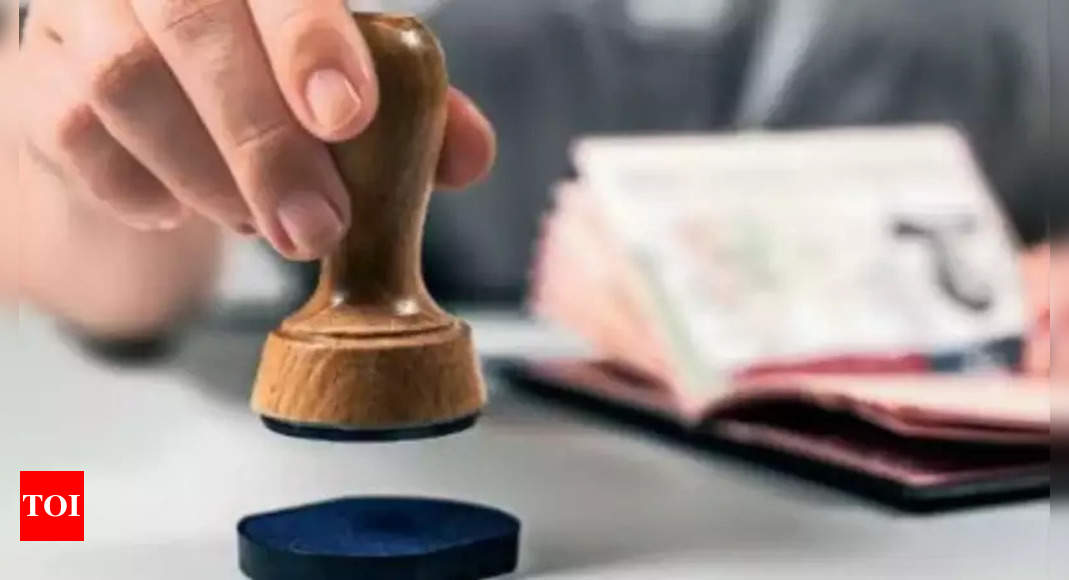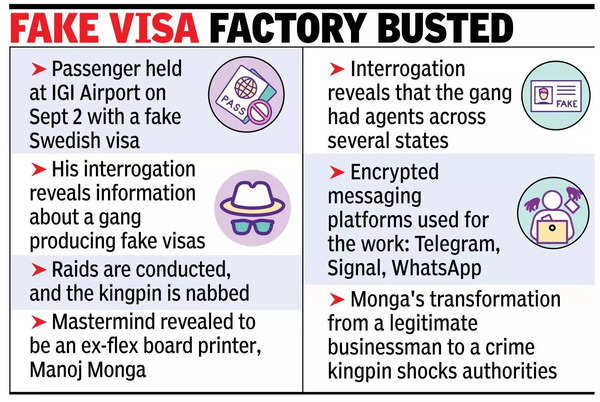
NEW DELHI: The rags-to-riches story of Manoj Monga, the alleged mastermind nabbed by airport police for running a counterfeit visa factory, is one built on deception, greed and betrayal. From a humble beginning as a banner maker, Monga rose to infamy as the manipulator of a Rs 100-crore fake visa empire. His seemingly ordinary family life in Tilak Nagar belied the sophisticated counterfeit operation thriving behind closed doors.
His five-year cat-and-mouse game with law enforcement ended when an associate’s revelation led police to his doorstep.Monga’s unassuming residence at Tilak Nagar gave no hint of the illegal enterprise within. Inside, a spacious hall was stocked with hundreds of stamps, meticulously organised paperwork and essential stationery.
Monga used software like Photoshop and Corel to design and store samples of visas of various countries. His computer was organised with templates for quick and accurate visa production. He had actually undertaken a graphic design course in a private college to refine his skills at creating high-precision fake visas, police said.

Sub-inspector Madan Lal, the investigating officer, reported that the accused appeared to be an ordinary family man, living with his teacher wife and their two children. His son is studying in a Delhi college, his daughter in Germany, supported by a loan. It was therefore a time of deep distress for the family to find the cops raiding their home.
Lal revealed that Monga created 20-30 counterfeit visas per month for his clients. The price of each fake visa varied depending on the customer’s desperation and urgency. When he worked as a banner maker, earning around Rs 5000 per banner, agents involved in the fraudulent visa trade approached him. They told him that a single visa could fetch at least Rs 1 lakh. Enticed by the prospect of high earnings, he gave in to a life of crime.
The investigation leading to his arrest spanned 15 days. Monga used just one phone, usually switching it on for a single call to connect with fraudulent agents and customers before promptly putting the device off. This careful routine made it nearly impossible to track his phone.
His evasion of police finally ended when an associate, already in custody, was sent to his home to request a fake visa. This setup lured Monga into a trap, leading to his arrest and the subsequent raid on his house. With over 150 fraudulent visa agents arrested, IGI Airport police have now charted the small-scale operations behind these schemes that are estimated to have earned over Rs 100 crore. Police are now focusing on dismantling these visa-making factories, uncovering a network of operations run from modest home offices.
DCP Usha Rangnani of IGI Airport has provided insights into distinguishing between fake and genuine visas. She highlighted several key differences: counterfeit visas often have spelling errors, discrepancies in UV features and variations in barcodes compared with those issued by embassies. The airport security department frequently updates its watermark detection to combat fake visas. However, criminals now employ advanced techniques and enhanced their UV and rubber stamps to produce highly convincing forgeries, making detection increasingly challenging, Rangnani said.





